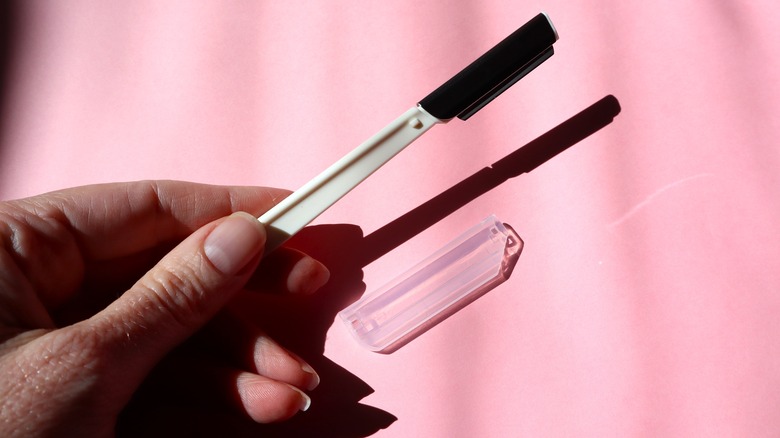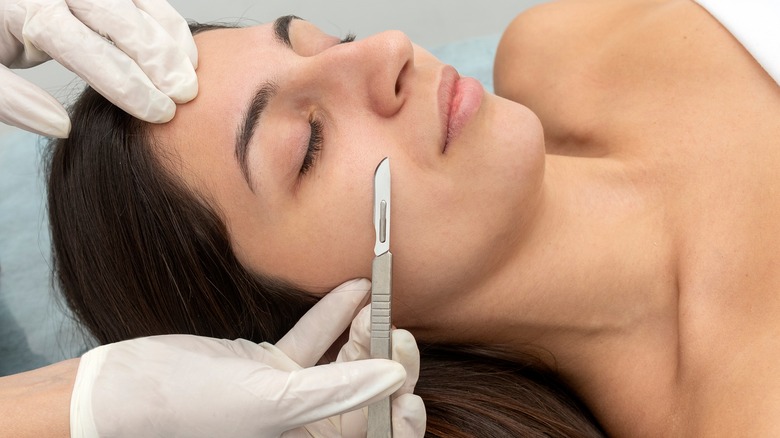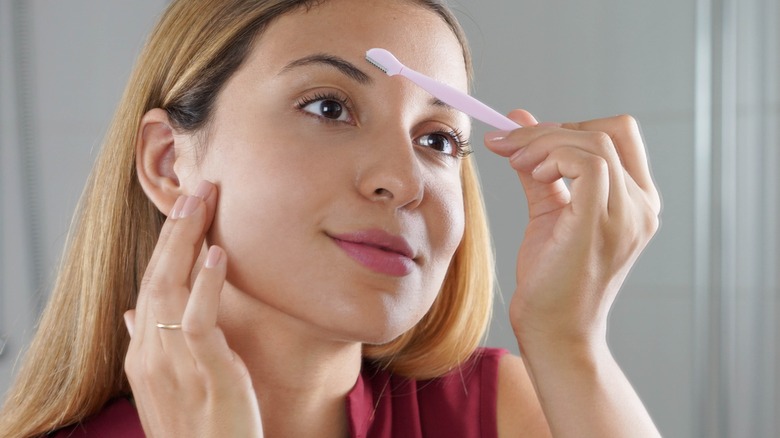What To Know Before You Try Dermaplaning
While it's true that the condition of your skin is largely determined by DNA and environmental factors, how you care for your skin through diet and your beauty regimen also plays a significant role in its overall health. With an overwhelming myriad of skincare trends and treatments on the market, it's hard not to be swayed by the clamor of the mob. While it's not humanly possible to try all the "fountains of youth" in one's lifetime, it's good to keep tabs on what's new to expand your options.
Dermaplaning is a budget-friendly beauty treatment that's gained major popularity with skincare fans over the past few years. During this minimally invasive procedure, a healthcare provider scrapes vellus hair and dead skin cells off your face with a special razor, per WebMD. The method is reported to give newer, unscathed skin by reducing acne scars and fine lines on the face. What's more? You can dermaplane at home all by yourself. All you need for a safe at-home procedure is a dermatology-grade blade designated to shave peach fuzz and exfoliate the skin, according to Jasclair Skincare. Let's find out what you can expect from this alleged quick fix for dull, uneven skin.
Dermaplaning makes your face a great canvas for makeup
Dermaplaning, with its exfoliating power, is an excellent choice for those looking to reduce fine lines and even out the skin tone to create a smooth base for makeup, dermatologist Mona Gohara told Glamour. Dermaplaning is generally safe for most people, and you can purchase exfoliating devices designed for at-home use on Amazon or at drugstores. However, if it's your first time and you don't know your way around sharp objects, you might want to employ the service of a professional. During the procedure, a specialist will aim a sterile, razor-like blade at a 45-degree angle on your skin's surface and, in short strokes, shave off the top layer of your skin, aiming to rid your skin of dead cells caused by environmental toxins, per Healthline. By clearing away dull, damaged skin cells, you can expect a smoother and more even skin surface.
During a dermaplaning session, you can expect to feel a tingly sensation as the blade is dragged across your skin. If you feel pain, reduce the force applied to the blade or skip the area. Depending on your needs, dermaplaning usually takes 30 to 45 minutes. Following a dermaplaning treatment, you may notice skin redness and a burning sensation on the treated area for up to 48 hours. Therefore, refresh the treated skin with cool water and soften your face with moisturizer or soothing serum. Avoid direct sun exposure, heat, and physical activity for about three days to prevent skin irritation.
Short-term effects of dermaplaning
While dermaplaning is considered a low-risk procedure, it's not the best option for every skin type and condition. "The treatment should not be performed if you have any inflammatory skin conditions including rosacea, psoriasis, eczema, sunburn or acne," cosmetic physician Dr. Najia Shaikh tells Metro. If you have swelling, and pus-filled pimples on your face, pressing a blade against your skin will only exacerbate your condition. Dr. Shaikh also mentions that, in rare cases, dermaplaning might cause darker hair to grow near the treated areas, such as your chin, upper lip, or the sides of your face. Another thing to keep in mind is that dermaplaning can end very badly if done improperly. Accidents that involve losing control of the scalpel and permanently scarring the face are not unheard of, says cosmetic doctor Dr. Jonquille Chantrey to Harper's Bazaar.
Dermaplaning is a quick-fix procedure that helps gloss over skin blemishes and prime your face for makeup. It's worth a shot, but the results are generally short-lived. Following the treatment, your facial hair will regrow, and pollutants will build up on your skin, necessitating dermaplaning every three to six weeks. Dermaplaning can give you skin that is pleasing to the eyes and delicate to the touch, but it is a treatment that must be maintained in order to achieve consistent results.


